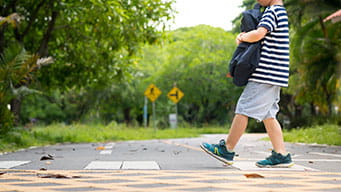
School's Open Drive Carefully
IN THE SCHOOLS
Mornings can be a dangerous time, as students travel to the bus stop, ride their bikes or walk to school. Afternoons present additional risks because children are often distracted by thoughts of playtime and other activities on their journey home.
 More school-age pedestrians have been killed from 7 a.m. to 8 a.m. and from 3 p.m. to 4 p.m. than any other times of day. Motorists need to be especially cautious during these times. School zone speed limits are in place to slow motorists and help save lives.
More school-age pedestrians have been killed from 7 a.m. to 8 a.m. and from 3 p.m. to 4 p.m. than any other times of day. Motorists need to be especially cautious during these times. School zone speed limits are in place to slow motorists and help save lives.
At the beginning of each school year, materials are distributed in each region to help promote our “School Open-Drive Carefully” campaign. Our goal is to work actively within our communities to help decrease child injuries and fatalities due to car crashes.
You can make a difference by staying alert and taking extra care while driving in areas where school children are present.
FOR DRIVERS
- Review your travel route. Can you avoid school zones and residential neighborhoods?
- Allow extra travel time for delays due to traffic slowdowns when school is in session.
- Slow down. ALWAYS adhere to speed limits in school zones and be prepared to stop quickly for pedestrians.
- Obey traffic signs. Slow down and always come to a complete stop at stop signs.
- Eliminate distractions while driving (phone, food, personal grooming, GPS, passengers, etc.). Be alert and ready for pedestrians who appear unexpectedly.
- Be aware of areas with children. AAA School Safety Patrollers, crossing guards, bicycles and playgrounds are signs to slow down and be alert.
- Watch for bicycles. Children on bikes are often inexperienced and unpredictable. Slow down and move over.
- Always stop for school busses. Flashing yellow lights = slow down and prepare to stop. Red flashing lights and extended stop sign = stop and wait. When red lights stop flashing and stop sign is withdrawn, you may begin driving again.
- Talk to your teen. More than one-in-four fatal teen driver crashes occur during the after-school hours of 3 to 7 p.m.
- Reverse responsibly. Check for children on the sidewalk, driveway and around your vehicle before slowly backing up.
- Use headlights. Turn on your headlights—even during the day—so you are more visible to children and other drivers.
- Use extra caution in bad weather. Rain, snow, fog or any other inclement weather reduces visibility for children and drivers and can make quick braking difficult.
Traffic Safety Programs & Materials
Please wait...







